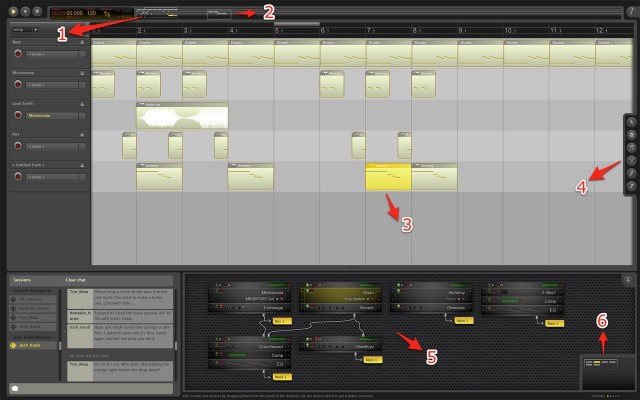Does the world really need another DAW / music production tool?
That thought has to at least echo a couple of times in the back of your mind as you see a new attempt to provide all-in-one computer music making tools. But there are reasons to pay attention to Ohm Studio, aside from the fact that the music making application comes from a fairly beloved plug-in developer. One is, the tool promises to approach real-time collaboration and community (or “cohmunity,” as they say) from the ground up. It’s a desktop app for the cloud. That may or may not be of interest to you, but it at least provides differentiation.
Two, this week we get to find out that the UI looks quite gorgeous.
Cid Andrade of Ohm Force writes CDM with three screenshots of the new interface for the upcoming beta builds. (Previously, we had seen only alpha UIs.) It looks clean and clear; there are strong similarities to GarageBand (which in turn borrowed functionally from Acid), but with some twists. There are quick-access edit tools, freely-routable plug-ins, and lots of integrated tools for collaboration.
Cid walks CDM through what’s in the beta interface and how it works; see the callouts in the image below. (Thanks, Skitch!)
Cid explains:
1 – Sequencing Panel’s “Macro Viewer”: gives an overview of the whole sequence. The movable focus-square has two functions: it allows the user to navigate within the macro viewer and easily locate and go to some region of the sequence, and also shows to all other session members which sequence region the user is working on. In this example, this focus-square is the one controlled by the user who’s actually seeing this screen. It’s over the current selected pattern. All other session members will also see this user’s focus-square, so they will know what he’s working on. There will be an efficient color code allowing a quick visualization of each session member’s focus-squares and current selections.
2 – In this example, the macro-viewer is displaying two focus-squares, what would mean that there are two members working simultaneously in this session. The user who’s actually seeing this screen also sees this second focus-square (the one belonging to the other member) and thanks to that can know where in the sequence he/she is working on. Still, in this example, one user may be editing some rhythmic parts in the sequence intro while the other one is starting to compose a bass line later in the timeline.
3 – This is the current selection of the user who’s seeing this screen. The other members can see a colored pattern in one of the focus-squares that the macro-viewer is displaying. By the color they’ll know which user is.
4 – These are the “power tools”. An user will be able to make all possible audio/MIDI edits using only these tools, as their function can be altered by pressing some keys (of course each edit action will have its respective keyboard shortcut so none will be obliged to use the mouse all the time).
5 – This is the Gear Panel, where the members of a session will place (and freely route) audio effects and virtual instruments (in addition of Ohm Studio’s own built-in effects, it will support VST and VSTI).
6 – The Gear Panel’s macro-viewer. Works similarly to the Sequencing Panel’s one, this time allowing an user to navigate within the Gear Panel (which is virtually infinite in area) to easily locate a specific region. It’s also useful to let each session member know on which Gear Panel’s region the other users are working on, and see/show each one’s current selections.
Thanks, Cid!
The beta is scheduled to start mid-December. There’s still time to sign up, says Cid, if you’re interested in testing.
http://www.ohmstudio.com/ask/for/beta
…and Ohm have plenty of other information about how they’re handling collaboration, community, and versioning, all essential when your project is shared by others:
